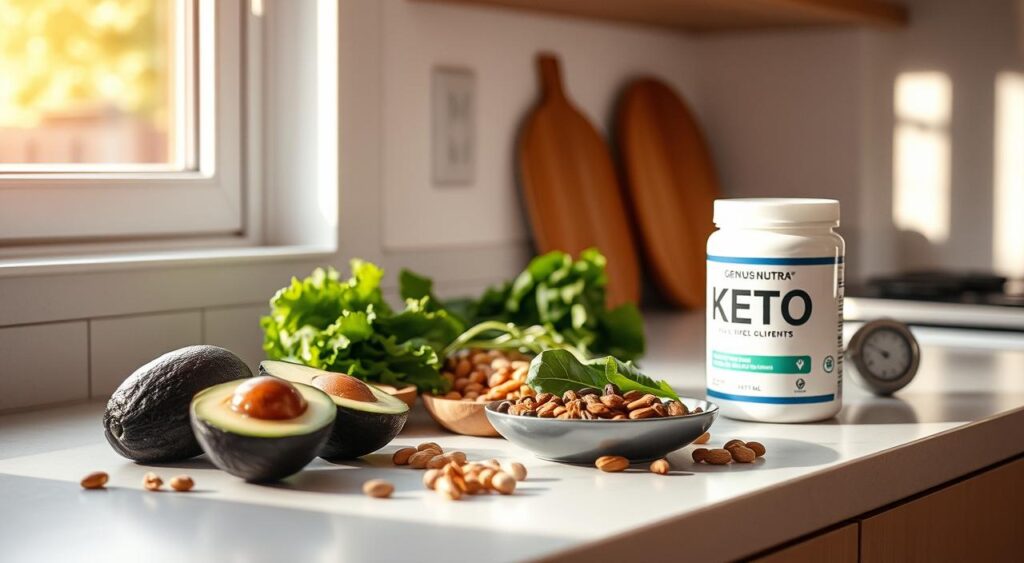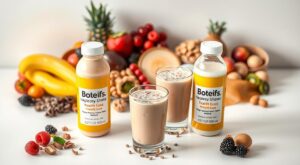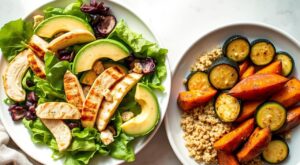Are you ready to change how you see food and health? Many think they know the ketogenic diet, but most advice is wrong. It can even slow you down.
As you start the keto diet, it’s key to find what really works. This guide will help you with the right steps. It will challenge common myths about this low-carb lifestyle.
Starting a keto diet can be rewarding and fit your needs perfectly. Let’s dive into how you can make it work for you.
Understanding the Basics of the Ketogenic Diet
The ketogenic diet is a popular way to eat. It focuses on lots of fat and few carbs. Learning about it can help you start a healthier life. You’ll find it’s great for losing weight and feeling better overall.
What Is a Ketogenic Diet?
This diet is all about eating a lot of fats, about 70% of your calories. You also eat moderate amounts of protein, around 20%. And you keep carbs very low, under 50 grams a day. This change makes your body use fat for energy instead of carbs, entering a state called ketosis.
How Does It Work?
When you’re in ketosis, your body gets really good at burning fat. This happens because you’re not eating many carbs. To start, follow some keto diet tips for beginners. Eat healthy fats, good proteins, and don’t eat too many carbs to stay in ketosis.
Benefits of a Ketogenic Diet
There’s more to the ketogenic diet than just losing weight. People often see quick weight loss, less hunger, and clearer thinking. It might even help with epilepsy and type 2 diabetes. Learning about the ketogenic diet can improve your health in many ways.
Common Myths About the Ketogenic Diet
When you look into the ketogenic diet, you might hear many myths. These myths can confuse your view of this eating plan. Let’s clear up some common misconceptions to help you feel more confident on the keto path.
Myth 1: It’s Just Another Low-Carb Diet
Many think the ketogenic diet is just about eating less carbs. But it’s more than that. It also focuses on eating a lot of fat. This mix is key to getting into ketosis, where your body burns fat for energy.
So, seeing it only as a low-carb diet misses the fat’s important role.
Myth 2: It’s Unhealthy for Your Body
Some believe the keto diet is bad because it’s high in fat. But, it can be healthy if you choose the right fats. Foods like avocados, olive oil, and nuts are good choices.
Studies show it can even help your heart and aid in weight loss. It’s about picking the right fats and balancing your diet.
Myth 3: You Can’t Eat Fruits and Vegetables
Many think you can’t eat fruits and veggies on the keto diet. But that’s not true. You can eat some fruits and veggies, just pick low-carb ones.
Leafy greens, zucchini, avocados, and berries are okay. They give you important nutrients without ruining your diet goals. This myth can make you think you can’t enjoy many foods on keto.

Getting Started on a Ketogenic Diet
Starting a keto diet needs careful planning and preparation. First, think about your health goals and what you need from your diet. Knowing what you want to achieve, like losing weight or feeling more energetic, helps guide you. Then, making a good beginner keto meal plan is key to your success.
Assessing Your Goals and Needs
Start by clearly defining what you want from your diet. Consider your current health, lifestyle, and goals, like losing fat or controlling blood sugar. A plan tailored to these goals will help you achieve lasting results.
Creating a Meal Plan
Creating a keto diet meal plan means focusing on whole foods. Include healthy fats, proteins, and low-carb veggies. This keeps you full and in ketosis. Look at sample beginner keto meal plans to see what a day’s eating looks like.
Shopping for Keto-Friendly Foods
When shopping for keto, choose meats, fish, dairy, nuts, and low-carb veggies. Make a list to avoid buying unhealthy foods. Sticking to your list helps you stay on track with your keto lifestyle.

Essential Foods for a Successful Ketogenic Diet
To succeed on a ketogenic diet, you need to eat a variety of foods. These foods help you stay in ketosis and keep your body healthy. A good mix of fats, proteins, and vegetables is key for your energy and health.
Healthy Fats to Include
Healthy fats are the heart of the ketogenic diet. Adding avocado, olive oil, and nuts to your meals is a great idea. They taste good and are good for you. Fatty fish like salmon is also a great choice, packed with omega-3s.
These fats keep you full and support your body’s functions. Make sure to include these keto-friendly foods for the best health.
Protein Sources You Can Trust
Proteins are essential on a ketogenic diet, and there are many good options. Include eggs, poultry, and high-quality dairy products in your diet. They are low in carbs, helping you stay balanced and supporting muscle health.
Chicken, for example, is high in protein and helps keep you full. It’s a great choice for your meals.
Low-Carb Vegetables
Don’t forget about vegetables when planning your meals. Choose low-carb options like leafy greens like spinach and kale. They are full of vitamins and minerals.
Other good choices are broccoli, zucchini, and peppers. These veggies add color and texture to your meals. They also keep your carb intake low. A variety of these keto-friendly foods ensures you get all the nutrients you need.

Foods to Avoid on a Ketogenic Diet
Following a ketogenic diet means watching what you eat, avoiding high-carb foods. Knowing which foods to skip is key to staying in ketosis. Some foods have hidden carbs that can slow your progress, so it’s important to pick carefully.
Understanding Hidden Carbs
Even healthy foods can have hidden carbs on a keto diet. For example, “low-fat” products often use sugars or starches for taste. Always check labels and nutrition facts to spot hidden carbs. These can add up quickly and mess up your keto goals.
Processed Foods to Steer Clear Of
Stay away from processed foods on a ketogenic diet. They often have unhealthy ingredients and added sugars that can ruin your diet. Here are some common processed foods to avoid:
- Breads and pastas
- Snack foods like chips
- Certain sauces and condiments
Alternatives to Sugary Snacks
Craving something sweet? Choose healthier options instead of sugary snacks. Try these:
- Nuts (macadamias, almonds)
- Cheese cubes
- Dark chocolate (with at least 70% cocoa)
These snacks can curb your cravings without breaking your keto diet. Remembering these tips can help you avoid carbs effectively.

| Food Type | Hidden Carbs | Better Alternatives |
|---|---|---|
| Granola Bars | High in sugars | Nuts or seeds |
| Fruit Juices | High sugar content | Sparkling water with lemon |
| Potatoes | Starchy carbs | Cauliflower or zucchini |
How to Transition to a Ketogenic Diet
Switching to keto needs careful thought. You can go slow or fast, depending on what you prefer. Knowing what to expect in the first weeks can make your journey smoother.
Gradual vs. Immediate Transition
Going slow might help you avoid diet discomforts. It lets your body get used to keto at its own speed. Start by eating fewer carbs and more healthy fats.
On the other hand, jumping right in can make you lose weight fast and feel more energetic. Think about what fits your life better and choose wisely.
What to Expect in the First Few Weeks
The first weeks can be tough, with symptoms like fatigue, headaches, and mood swings. These are signs your body is learning to use fat for energy instead of carbs. Drinking water and eating foods rich in electrolytes can help a lot.
Maintaining Your Energy Levels
Keeping your energy up is key during this time. Eat enough healthy fats and protein to keep your body going. Foods like avocados, nuts, and fatty fish are great for energy and keeping you full.
Don’t forget to drink plenty of water. It helps fight fatigue and keeps you feeling good while you’re on keto.
Dealing with the Keto Flu
Starting a ketogenic diet can lead to changes. One big challenge is the keto flu. Your body is switching from using glucose to fat for energy. This can cause several symptoms that might feel uncomfortable.
Knowing these symptoms is the first step to managing keto flu.
Symptoms to Watch For
Common keto flu symptoms include:
- Headaches
- Fatigue
- Nausea
- Irritability
Being aware of these signs helps you act quickly if they happen during your diet change.
Tips to Alleviate Discomfort
Managing keto flu is easier with a few simple tips:
- Stay Hydrated: Drinking water helps remove toxins and keeps you healthy.
- Increase Salt Intake: Sodium helps keep electrolyte levels balanced during ketosis.
- Rest Well: Getting enough sleep helps your body adjust to the new energy source.
Adding these habits to your routine can lessen symptoms and make the transition easier.
When to Seek Help
While keto flu is common, some symptoms can be severe or last too long. If your symptoms get worse or don’t get better with self-care, see a doctor. They can check for other issues that might be causing your discomfort.
Meal Prep and Planning for Beginners
Meal prep for keto helps you stick to your diet. It keeps you away from high-carb foods. This guide offers easy keto recipes and batch cooking ideas to make your meals tasty and varied.
Easy Recipes to Try
Start with simple keto recipes for a strong base. Try these easy dishes:
- Stuffed bell peppers with ground beef and cheese
- Zucchini noodles tossed with olive oil and garlic
- Egg muffins with spinach and cheese
Batch Cooking Ideas
Batch cooking saves time when you’re busy. It lets you make keto meals in bulk. Here are some tips:
- Cook a big pot of cauliflower rice for different dishes all week.
- Make several servings of slow-cooked meats like shredded chicken or beef.
- Prepare a large salad with kale, avocado, and nuts for daily portions.
Keeping Your Meals Interesting
It’s key to keep your keto meals exciting. Try these ideas to mix up your meals:
- Use different herbs and spices to flavor your food.
- Try new sauces and dressings that fit your keto diet.
- Add seasonal veggies to keep your meals fresh and nutritious.
Monitoring Your Progress and Adjustments
Keeping track of your keto journey is key. It’s about watching different factors that help you succeed. Tracking well is vital to stay in ketosis and balance your nutrients right.
Tracking Your Macros
It’s important to track your macros on keto. This means watching your carbs, fats, and proteins. Apps or food diaries can help make it easier.
They let you see how foods affect your intake. This helps you adjust your diet. Knowing your macro ratios helps you optimize your diet and track your progress well.
Knowing When to Make Changes
Watch how your body reacts over time. If you feel tired or your weight stops going down, it might be time to change your diet. Pay attention to any signs of feeling bad or tired.
Learning how foods affect your blood sugar is helpful. A continuous glucose monitor (CGM) can give you insights. This helps you make better choices.
The Importance of Listening to Your Body
Your own experience on the ketogenic diet is the most important. Listening to your body helps you make the right changes. If you’re always tired or uncomfortable, check your diet.
Getting help from nutrition experts can also be helpful. They can give you advice that fits your health goals. Learn more about blood glucose monitoring and its role in your keto journey here.
Long-Term Strategies for Success on a Ketogenic Diet
To succeed on keto long-term, make keto a part of your daily life. This means fitting keto into social events and personal choices. A balanced lifestyle keeps you on track and boosts your health.
Maintaining a Balanced Lifestyle
It’s key to balance keto with everyday life. Choose keto-friendly meals at social events and find low-carb foods you love. This way, keto becomes a natural part of your life, not a chore.
The Role of Exercise
Regular exercise boosts keto’s benefits. Mix strength training with cardio for better health and fitness. Exercise improves mood and energy, helping you stay on keto for good.
Community Support and Resources
Connecting with keto friends is motivating. Use online forums or local groups to share tips and recipes. Support from others keeps you committed to your keto journey.














